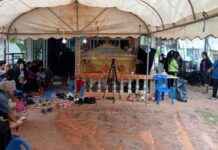**A Creative Solution to Save Endangered Species**
In a world facing unprecedented challenges in wildlife conservation, a unique and creative solution has emerged to address the urgent need to protect endangered species. The Chair Exchange program, pioneered by conservationists and wildlife experts, aims to harness the power of collaboration and resource-sharing among different organizations to maximize efforts in saving vulnerable species from extinction.
**The Concept of Chair Exchange**
The Chair Exchange program operates on a simple yet powerful premise: organizations involved in wildlife conservation exchange expertise, resources, and personnel to optimize their impact on protecting endangered species. By sharing knowledge, technology, and manpower, participating organizations can pool their strengths and tackle conservation challenges more effectively.
**Benefits of Chair Exchange**
One of the key benefits of the Chair Exchange program is the ability to leverage the specialized skills and resources of diverse organizations to address complex conservation issues. For example, a wildlife organization with expertise in habitat restoration may partner with a research institution specializing in genetic conservation to develop comprehensive strategies for preserving a critically endangered species.
Additionally, the Chair Exchange program promotes collaboration and knowledge-sharing among conservationists, fostering a culture of innovation and creativity in wildlife conservation efforts. By bringing together experts from different fields, the program encourages interdisciplinary approaches to conservation that can lead to breakthrough solutions for protecting endangered species.
Moreover, the Chair Exchange program enhances the capacity of organizations to respond to conservation emergencies and crises more effectively. In the event of a sudden threat to a vulnerable species, participating organizations can mobilize resources and expertise quickly through the exchange network, enabling rapid and coordinated conservation action.
**Success Stories of Chair Exchange**
Several success stories have emerged from the implementation of the Chair Exchange program in various conservation projects around the world. In one instance, a collaboration between a wildlife rehabilitation center and a veterinary hospital led to the successful rescue and rehabilitation of a critically endangered species of sea turtle. By combining their expertise in wildlife medicine and rehabilitation, the organizations were able to save multiple turtles and release them back into the wild.
In another example, a partnership between a conservation NGO and a technology company resulted in the development of a cutting-edge monitoring system for tracking the movements of endangered big cats in the wild. The innovative technology, powered by artificial intelligence and satellite tracking, revolutionized the way researchers study and protect these iconic species, leading to significant advancements in big cat conservation efforts.
**The Future of Chair Exchange**
As the Chair Exchange program continues to gain momentum and recognition in the conservation community, its potential to drive positive change in wildlife conservation is boundless. By fostering collaboration, innovation, and resource-sharing among organizations, the program holds the promise of transforming the landscape of endangered species conservation and ensuring a sustainable future for wildlife around the globe.
In conclusion, the Chair Exchange program represents a beacon of hope in the fight to save endangered species from extinction. Through collaboration, creativity, and a shared commitment to conservation, organizations participating in the program are making significant strides in protecting vulnerable species and preserving biodiversity for future generations. As we look to the future, the Chair Exchange program stands as a shining example of the power of partnership and collective action in safeguarding the natural world.

















